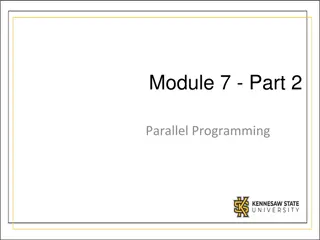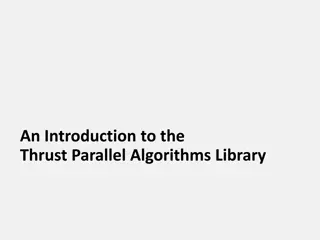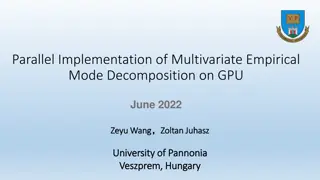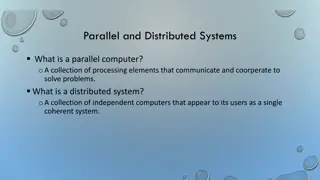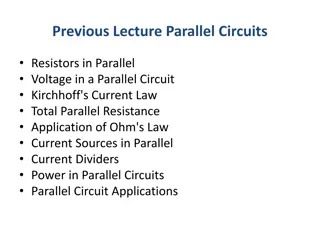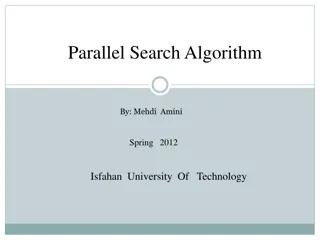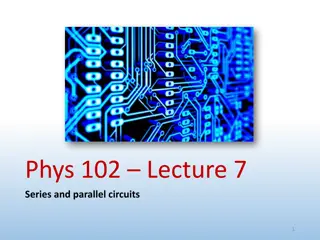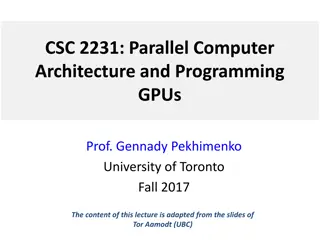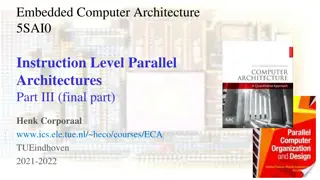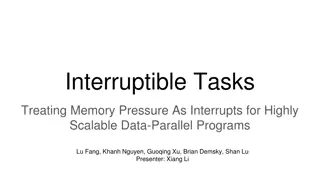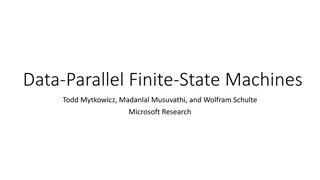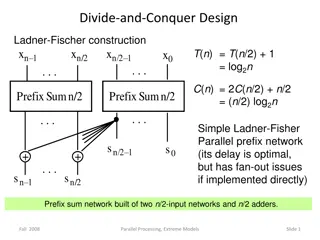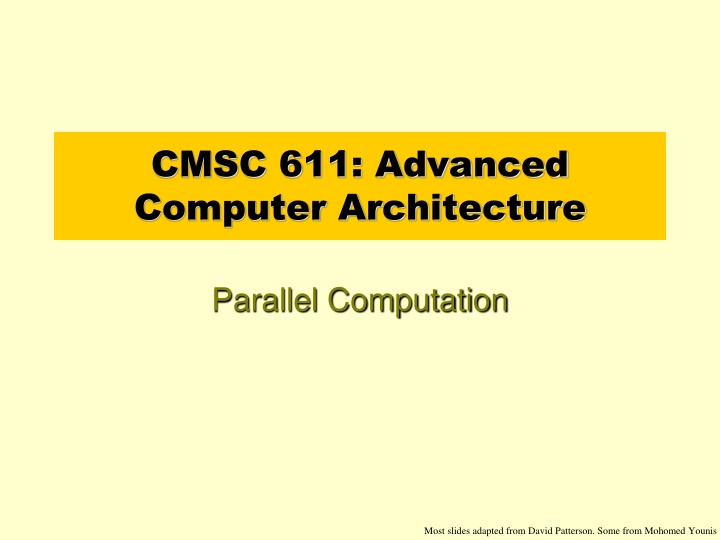
Advanced Computer Architecture: Enhancing Parallel Computation Efficiency
Explore the significance of parallel computers in solving large problems quickly, the different levels of parallelism, applications in scientific and commercial sectors, and the framework for extending traditional computer architecture for efficient communication and abstraction realization.
Download Presentation

Please find below an Image/Link to download the presentation.
The content on the website is provided AS IS for your information and personal use only. It may not be sold, licensed, or shared on other websites without obtaining consent from the author. If you encounter any issues during the download, it is possible that the publisher has removed the file from their server.
You are allowed to download the files provided on this website for personal or commercial use, subject to the condition that they are used lawfully. All files are the property of their respective owners.
The content on the website is provided AS IS for your information and personal use only. It may not be sold, licensed, or shared on other websites without obtaining consent from the author.
E N D
Presentation Transcript
CMSC 611: Advanced Computer Architecture Parallel Computation Most slides adapted from David Patterson. Some from Mohomed Younis
2 Parallel Computers Definition: A parallel computer is a collection of processing elements that cooperate and communicate to solve large problems fast. Almasi and Gottlieb, Highly Parallel Computing,1989 Parallel machines have become increasingly important since: Power & heat problems grow for big/fast processors Even with double transistors, how do you use them to make a single processor faster? CPUs are being developed with an increasing number of cores
3 Questions about parallel computers: How large a collection? How powerful are processing elements? How do they cooperate and communicate? How are data transmitted? What type of interconnection? What are HW and SW primitives for programmers? Does it translate into performance?
4 Level of Parallelism Bit-level parallelism ALU parallelism: 1-bit, 4-bits, 8-bit, ... Instruction-level parallelism (ILP) Pipelining, Superscalar, VLIW, Out-of-Order execution Process/Thread-level parallelism Divide job into parallel tasks Job-level parallelism Independent jobs on one computer system
5 Applications Scientific Computing Nearly Unlimited Demand (Grand Challenge): Successes in some real industries: Petroleum: reservoir modeling Automotive: crash simulation, drag analysis, engine Aeronautics: airflow analysis, engine, structural mechanics Pharmaceuticals: molecular modeling Perf (GFLOPS) Memory (GB) App 48 hour weather 72 hour weather Pharmaceutical design Global Change, Genome 0.1 3 0.1 1 100 10 1000 1000
6 Commercial Applications Transaction processing File servers Electronic CAD simulation Large WWW servers WWW search engines Graphics Graphics hardware Render Farms
7 Framework Extend traditional computer architecture with a communication architecture abstractions (HW/SW interface) organizational structure to realize abstraction efficiently Programming Model: Multiprogramming: lots of jobs, no communication Shared address space: communicate via memory Message passing: send and receive messages Data Parallel: operate on several data sets simultaneously and then exchange information globally and simultaneously (shared or message)
8 Communication Abstraction Shared address space: e.g., load, store, atomic swap Message passing: e.g., send, receive library calls Debate over this topic (ease of programming, scaling) many hardware designs 1:1 programming model
9 Taxonomy of Parallel Architecture Flynn Categories SISD (Single Instruction Single Data) MIMD (Multiple Instruction Multiple Data) MISD (Multiple Instruction Single Data) SIMD (Single Instruction Multiple Data)
10 SISD Uniprocessor
11 MIMD Multiple communicating processes
12 MISD No commercial examples Different operations to a single data set Find primes Crack passwords
13 SIMD Vector/Array computers
14 SIMD Arrays Performance keys Utilization Communication
15 Data Parallel Model Operations performed in parallel on each element of a large regular data structure, such as an array One Control Processor broadcast to many processing elements (PE) with condition flag per PE so that can skip For distributed memory architecture data is distributed among memories Data parallel model requires fast global synchronization Data parallel programming languages lay out data to processor Vector processors have similar ISAs, but no data placement restriction
16 SIMD Utilization Conditional Execution PE Enable if (f<.5) {...} Global enable check while (t > 0) {...}
17 Communication: MasPar MP1 Fast local X-net Slow global routing
18 Communication: CM2 Hypercube local routing Wormhole global routing
19 Data Parallel Languages SIMD programming PE point of view Data: shared or per-PE What data is distributed? What is shared over PE subset What data is broadcast with instruction stream? Data layout: shape [256][256]d; Communication primitives Higher-level operations Scan/Prefix sum: [i]r = j i [j]d 1,1,2,3,4 1,1+1=2,2+2=4,4+3=7,7+4=11
20 Single Program Multiple Data Many problems do not map well to SIMD Better utilization from MIMD or ILP Data parallel model Single Program Multiple Data (SPMD) model All processors execute identical program Same program for SIMD, SISD or MIMD Compiler handles mapping to architecture
21 MIMD Message Passing Shared memory/distributed memory Uniform Memory Access (UMA) Non-Uniform Memory Access (NUMA) Can support either SW model on either HW basis
22 Message passing Processors have private memories, communicate via messages Advantages: Less hardware, easier to design Focuses attention on costly non-local operations
23 Message Passing Model Each PE has local processor, data, (I/O) Explicit I/O to communicate with other PEs Essentially NUMA but integrated at I/O vs. memory system Free run between Send & Receive Send + Receive = Synchronization between processes (event model) Send: local buffer, remote receiving process/port Receive: remote sending process/port, local buffer
24 History of message passing Early machines Local communication Blocking send & receive Later: DMA with non-blocking sends DMA for receive into buffer until processor does receive, and then data is transferred to local memory Later still: SW libraries to allow arbitrary communication

